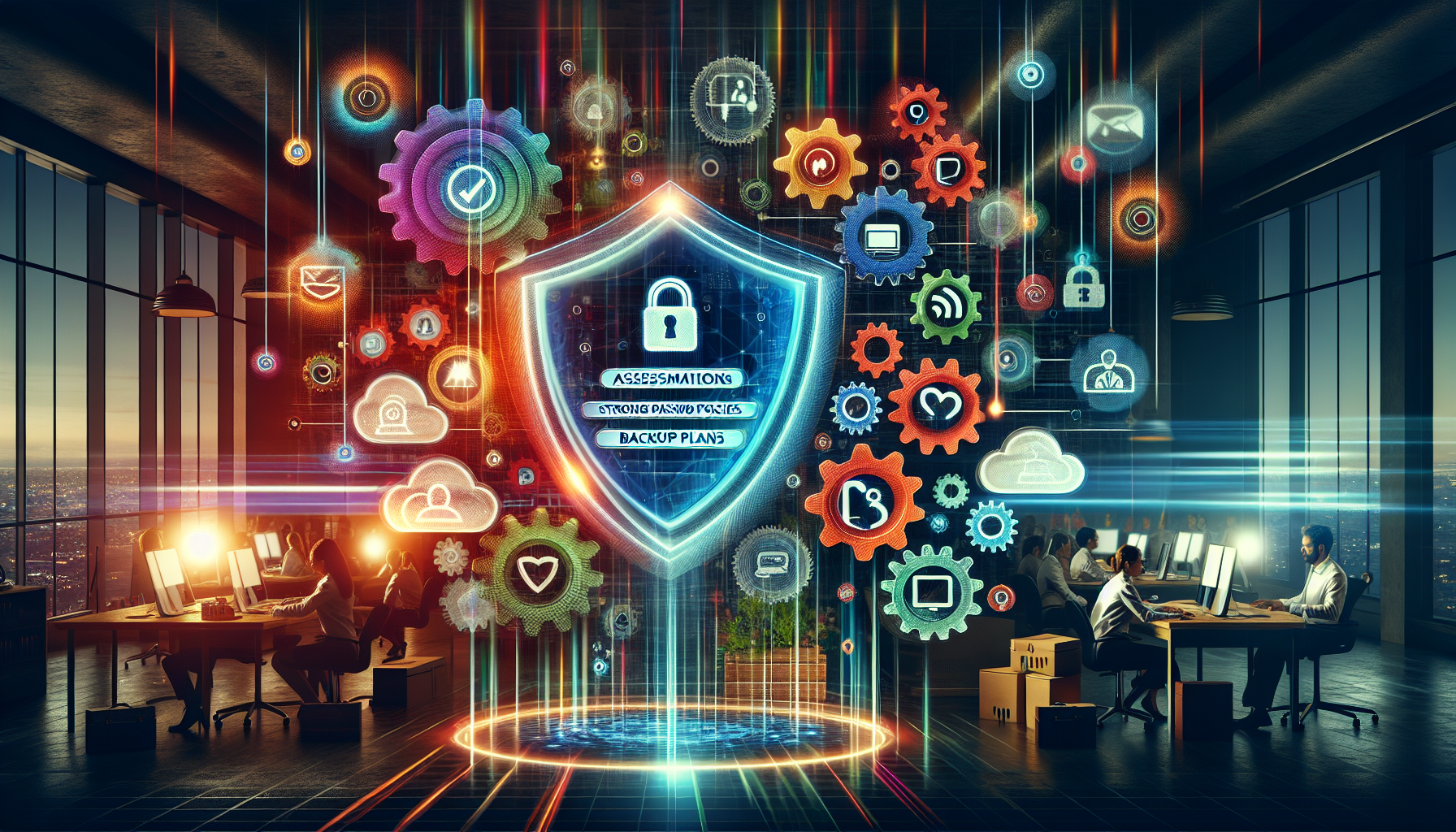As a small to medium-sized business (SMB) owner, I understand the importance of SMB cyber security in safeguarding my business assets and sensitive information. Cyber threats continuously evolve and pose significant risks to businesses of all sizes.
However, SMBs often face unique challenges due to limited resources and budgets, making them particularly vulnerable. By implementing effective cyber security practices, I can protect my business from potential breaches and ensure that my customers’ data remains secure, building trust and maintaining a powerful reputation in the marketplace.
Staying updated with cybersecurity trends is vital for SMBs to strengthen their defense mechanisms.
Key Takeaways
- SMBs must prioritize cybersecurity, as 43% of cyber attacks target them. They require a robust defense despite limited resources and expertise.
- Key elements of an effective cybersecurity strategy include employee training, multi-factor authentication, and regular software updates to mitigate potential threats.
- Utilizing government and industry resources can enhance SMB cybersecurity, offering valuable guidance and tools to address evolving cyber threats.
Understanding SMB Cyber Security Challenges

Enhancing your SMB’s cybersecurity begins with understanding the unique challenges. Limited resources and budgets make investing in comprehensive solutions difficult for many SMBs. Additionally, the absence of in-house expertise often leaves SMBs vulnerable to cybersecurity risks. Recognizing these challenges is key to developing an effective cybersecurity strategy.
A common misconception among SMBs is that their size shields them from cyber criminals. However, statistics show that 43% of all cyber attacks annually target SMBs, highlighting the significant risk exposure and the need to prioritize cybersecurity.
Data breaches can severely impact SMBs. Limited resources and expertise often leave SMBs ill-equipped to handle the financial and reputational damage caused by such breaches. Recognizing these challenges is the first step toward building a robust cybersecurity defense.
1. Limited Resources
SMBs often struggle with tight budgets, significantly limiting their ability to invest in cybersecurity. The perception that cybersecurity solutions are expensive further deters many SMBs from implementing necessary protections. However, this leaves them vulnerable to cyber threats and makes them easy targets for cybercriminals.
Despite these financial constraints, resources are available to help SMBs invest in cybersecurity. Financial incentives can offer essential support. Examples include tax breaks, government grants, and subsidies. Leveraging these resources enables SMBs to create a more secure environment for their business, employees, and customers.
2. Lack of Expertise
A significant challenge for SMBs is the lack of in-house cybersecurity expertise. About 27% of small businesses reported lacking the necessary expertise to manage their cybersecurity needs. Additionally, many SMBs face difficulties finding qualified cybersecurity professionals, with 30% of businesses reporting that over half of their cybersecurity applicants did not meet minimum qualifications.
This skills gap often leads to a lack of understanding of specific cyber threats and underestimating the risks. As a result, SMBs become more vulnerable to cyber-attacks. Closing this expertise gap is essential for developing a robust cybersecurity strategy.
3. High Impact of Data Breaches
The effects of data breaches can be particularly devastating for SMBs. A study conducted by Cisco in 2018 revealed that more than 52% of small and medium-sized businesses (SMBs) faced at least one data breach. This statistic highlights the vulnerability of SMBs to security threats. This number has only increased over the years, with a 50% rise in the number of SMBs reporting data breaches since 2017.
Data breaches can cause significant financial loss and reputational damage, which SMBs are often less equipped to handle than larger enterprises. The high cost of recovery and potential loss of customer trust underscores the need to implement robust cybersecurity measures to protect sensitive data.
Key Elements of an Effective SMB Cybersecurity Strategy
Defending against cyber attacks requires SMBs to develop a comprehensive cybersecurity strategy. This strategy should include employee training and awareness, multi-factor authentication, and regular software updates and patch management.
Employee training is vital because employees can inadvertently bypass security measures. Multi-factor authentication (MFA) adds another security covering, making unauthorized access considerably harder. Frequent application updates and patch management reduce exposures that cyber attackers might exploit.
Focusing on these key elements allows SMBs to create a robust cybersecurity framework that protects against a wide range of cyber threats.
1. Employee Training and Awareness
Employees are the first line of defense against cyber threats, making their training and awareness crucial. Regular training sessions can greatly reduce the likelihood of human errors leading to security breaches, and improving cybersecurity awareness among employees can greatly decrease the number of cyber incidents.
It is vital to continuously educate employees about the latest cyber threats and security methods. Different methods of cybersecurity education, such as highlighting phishing tactics, can enhance employee awareness and empower them to respond effectively.
Establishing the significance of cybersecurity through leadership fosters a culture that prioritizes safety. Investing in employee training equips SMBs with a knowledgeable workforce prepared to recognize and respond to potential threats.
2. Multi-Factor Authentication (MFA)
Multi-factor authentication (MFA) is a safety action that requires multiple forms of identification to access accounts. This added layer of protection makes it extremely hard for unauthorized individuals to gain access. MFA can be enforced through various methods, such as obtaining a text message with a PIN number or using biometric identification.
Incorporating MFA into their cybersecurity strategy enhances network security and protects sensitive information. This modern solution is a critical component of any comprehensive cybersecurity plan.
3. Regular Software Updates and Patch Management
Keeping software up-to-date mitigates vulnerabilities that attackers might exploit. Regularly updating systems closes security gaps that cyber threats could target. Maintaining an updated software inventory ensures all systems have the necessary security patches.
Timely patching of software and systems significantly enhances cybersecurity posture and minimizes risk. Prioritizing regular software updates and patch management protects SMB networks and data from potential cyber threats.
Essential Cybersecurity Solutions for SMBs

Implementing essential cybersecurity solutions is vital for SMBs to protect their valuable data assets. This includes the latest security software, web browsers, and operating systems to defend against viruses and malware. Regularly updating antivirus software ensures that computers have the latest cyber threat libraries.
In addition to antivirus software, SMBs should consider tools like:
- ThreatBlock and Deep Packet Inspection (DPI) to identify and block potential threats
- Domain Name System (DNS) protection to prevent access to harmful websites and filter unwanted content
- Intrusion Detection and Prevention Systems (IDS/IPS) examine data packets to block various types of threats.
Leveraging these cybersecurity solutions allows SMBs to create a strong defense against cyber attacks and protect their network from cyber criminals.
1. Antivirus Software
Antivirus software plays an important part in cybersecurity for SMBs by detecting and stopping threats such as malware and ransomware. Modern antivirus solutions are capable of detecting a variety of malware threats beyond traditional computer viruses.
Regularly updating antivirus software ensures that computers have the latest threat libraries and can effectively defend against new cyber threats. Investing in reliable antivirus software enables SMBs to protect their data and devices from malicious software.
2. Secure Network Access
Securing network access protects sensitive data from cyber-attacks. Firewalls monitor internet traffic to and from the network, preventing outsiders from accessing data on a private network. Next-generation firewalls filter data, look for threats, and discard harmful packets, enhancing overall cybersecurity.
Virtual Private Networks (VPNs) encrypt data sent and received, preventing unauthorized access to information. Enforcing stringent access policies, such as IP Allowlisting and Network Segmentation, significantly lowers the chances of experiencing a breach.
Securing their networks ensures that only authorized personnel can access sensitive data and physical access, reducing the risk of cyber threats.
3. Data Encryption
Data encryption protects sensitive information both when stored and during transmission. Properly implemented encryption measures ensure that even if data is accessed or intercepted without authorization, it remains unreadable to unauthorized parties.
Not employing data encryption can lead to severe consequences, including loss of customer trust and data breaches. Incorporating encryption into their cybersecurity strategy allows SMBs to safeguard their critical data from cyber criminals.
Proactive Measures to Prevent Cyber Attacks
A proactive stance prepares employees and systems against cyber threats. Endpoint Detection and Response (EDR) solutions help identify and respond to potential threats connected to devices. Email gateway security blocks malicious emails, protecting user accounts from various threats.
Establishing alternative communication methods is crucial to maintaining contact during a cyber incident. Collaborating with a managed service provider can save costs by eliminating the overhead of in-house IT teams.
Implementing proactive measures strengthens SMB cybersecurity posture and minimizes recovery time after a cyber attack.
1. Conduct Regular Security Assessments
Regular assessments to identify weaknesses in your network are crucial for maintaining cybersecurity. Performing vulnerability assessments helps businesses identify network weaknesses to mitigate potential risks. Penetration testing ensures that your cybersecurity systems work effectively against new threats.
Regular security assessments allow SMBs to stay ahead of cyber threats and protect their network from potential attacks.
2. Implement Strong Password Policies
Implementing strong password policies is crucial for safeguarding sensitive information against unauthorized access. Enforcing unique and regularly changed passwords strengthens defenses against cyber threats. Weak or easily guessed passwords can lead to increased vulnerability, allowing unauthorized individuals to gain access to systems and data.
Requiring complex password creation and regular updates enhances SMB cybersecurity posture.
3. Backup and Recovery Plans
Regularly backing up data ensures that businesses can quickly restore operations and minimize losses after a cyber incident. Frequent backups make ransomware attacks minor events by allowing companies to restore data without giving in to extortion.
Backup copies of important business data should be stored in the cloud or offsite to protect against local disasters. It’s recommended that important business data be backed up at least weekly to secure recent information. Robust backup and recovery plans enable SMBs to quickly regain control after a cyber attack.
Compliance and Regulatory Requirements

Ensure Compliance with Cybersecurity Regulations
As a small to medium-sized business (SMB), ensuring compliance with various cybersecurity regulations is crucial to protect sensitive data and prevent cyber attacks. Compliance with rules such as the New York Department of Financial Services (NYDFS), the General Data Protection Regulation (GDPR), the Cybersecurity Regulation, and the Health Insurance Portability and Accountability Act (HIPAA) is important to avoid fines and reputational damage.
To ensure compliance, SMBs should:
- Conduct Regular Risk Assessments: Identify potential vulnerabilities in your systems and processes. Regular reviews help you stay ahead of emerging threats.
- Implement Necessary Controls: Based on the results of risk assessments, implement appropriate security controls to mitigate potential risks.
- Train Employees: Educate employees about cybersecurity best practices and their role in safeguarding sensitive data. Regular training sessions can help prevent accidental data breaches caused by human error.
- Monitor Compliance: Set up systems to monitor your organization’s compliance with regulations and identify any gaps that need to be addressed.
Incident Response and Recovery
A strong incident response and recovery plan is essential for any SMB to handle cybersecurity breaches and minimize damage efficiently. An effective strategy should include clear protocols for detecting, reporting, and addressing incidents.
Recovery is critical; once the immediate threat is neutralized, steps must be taken to resume normal operations. This includes restoring compromised systems or data and refining security measures to prevent future incidents. Conducting a post-incident analysis allows businesses to learn from breaches and identify gaps in policies or procedures.
Have an Incident Response Plan in Place
- Identification: Establish procedures for detecting cybersecurity incidents promptly. This includes utilizing monitoring tools and encouraging employees to report suspicious activities immediately.
- Containment: Implement strategies to isolate affected systems and prevent the spread of the breach. This could include disconnecting infected devices from the network and applying temporary safeguards.
- Eradication: Once containment is achieved, focus on eliminating the threat from the network. This may involve removing malware, closing vulnerabilities, and updating security patches.
- Recovery: Begin restoring systems and data to return to normal operations. Ensure all systems are thoroughly tested for integrity and security before bringing them back online.
- Lessons Learned: Conduct a detailed post-incident review to understand what happened and why. Use these insights to update and improve existing security protocols and response plans.
Leveraging Government and Industry Cybersecurity Resources

SMBs can significantly enhance their cybersecurity posture by leveraging available cybersecurity resources. The FCC’s Small Business Cyber Planner 2.0 is designed to help small businesses design customized cybersecurity plans. Additional resources are available that can provide guidance and best practices to further reduce cybersecurity risk for SMBs.
Utilizing governmental and industry resources helps SMBs create comprehensive cybersecurity strategies and stay informed about the latest cyber threats.
1. Government Agencies
The National Cyber Security Alliance offers resources specifically aimed at small and medium-sized businesses to enhance their cybersecurity practices. The National Institute of Standards and Technology (NIST) provides a dedicated resource for small businesses focused on cybersecurity guidance.
The Federal Trade Commission (FTC) provides tailored cybersecurity resources to assist small business owners in mitigating risks. Leveraging these resources enhances SMB cybersecurity measures and protects their networks from cyber threats.
2. More Cybersecurity Resources
In addition to government agencies, there are numerous industry-specific resources that SMBs can utilize to bolster their cybersecurity posture. The FCC has released an updated one-page Cybersecurity Tip Sheet to provide essential tips on cybersecurity, making it a valuable resource for small businesses. Following these guidelines enables SMBs to implement effective cybersecurity measures and reduce their vulnerability to cyber threats.
Industry groups and cybersecurity organizations often provide specialized tools and resources tailored to SMBs’ unique needs. These resources can help SMBs stay informed about the latest threats and best practices, ensuring they remain proactive in their cybersecurity efforts.
Common Cybersecurity Threats Facing SMBs
SMBs face a variety of cybersecurity threats that can disrupt operations and cause significant damage. These threats include data breaches, malware attacks, DDoS, phishing attacks, and spyware. SMBs are often perceived as easier targets due to their lack of strong defenses and inadequate understanding of specific risks.
Financial loss, reputational damage, and operational downtime are common consequences of cyber attacks for SMBs. End-user mistakes, such as clicking on malicious links, significantly increase vulnerability to cyber threats.
Understanding these common threats allows SMBs to take steps to protect their network and sensitive data.
1. Phishing Attacks
Phishing attacks are some of the most prevalent cyber threats facing SMBs. Nearly half of the attacks targeting SMBs are phishing attempts, highlighting a critical area for cybersecurity awareness and training. Phishing schemes often disguise themselves as legitimate requests to gain sensitive information from users.
Small and medium-sized businesses are disproportionately targeted by social engineering attacks, and they face them at rates significantly higher than larger organizations. Educating employees on identifying and reacting to phishing attacks reduces SMBs’ vulnerability to these threats.
2. Ransomware Attacks
Ransomware attacks encrypt a victim’s data and demand payment for the decryption key. These attacks can be devastating for SMBs, leading to significant financial loss and operational disruption. Phishing attacks are often a precursor to ransomware attacks, making it essential to address both threats.
Implementing robust cybersecurity measures, such as regular data backups and employee training, enables SMBs to mitigate the impact of ransomware attacks and recover quickly without giving in to extortion.
3. Insider Cyber Threats
Insider threats refer to risks posed by employees or contractors who have inside information concerning an organization’s security practices, data, and computer systems. These threats can lead to considerable data breaches, financial losses, and damage to the reputation of SMBs.
Implementing regular security assessments and strong password policies can help identify and mitigate insider threats. Creating and enforcing clear communication channels encourages employees to report suspicious behavior, enhancing the organization’s security posture.
Building a Culture of Cybersecurity in Your SMB

Creating a culture of cybersecurity within your SMB is essential for maintaining a strong defense against cyber threats. A cyber leader should champion cybersecurity, communicate its importance, and create a culture of cyber readiness. Establishing cybersecurity policies can foster a culture of security that enhances both business and consumer confidence.
Active involvement from all tiers of the organization, not just IT departments, is crucial for building a culture of cybersecurity. Promoting cybersecurity awareness and best practices ensures that all employees take responsibility for maintaining cyber hygiene.
1. Leadership Commitment
Leadership commitment is key to fostering a cybersecurity culture. Building awareness and offering training on best practices is a vital step in developing a cybersecurity culture within an SMB. Periodically reminding colleagues of the importance of cyber hygiene enhances the overall cybersecurity culture.
Company policies regarding IT asset usage govern the use of IT assets to protect IT systems. Demonstrating a commitment to cybersecurity inspires employees to prioritize and adhere to security measures.
2. Ongoing Education
Ongoing education is crucial for SMBs to stay updated on evolving cyber threats and defenses. Regular cybersecurity training for employees helps them recognize and prevent potential threats, including phishing and other types of attacks.
Regular security assessments allow SMBs to identify vulnerabilities and strengthen their cybersecurity posture. Leveraging government and industry cybersecurity resources provides employees with the guidance and tools needed to enhance their defenses.
3. Clear Communication Channels
Establishing clear communication pathways is crucial for promptly reporting cybersecurity incidents and concerns. Having defined communication pathways helps employees report cybersecurity concerns swiftly and effectively.
Promoting an open environment encourages employees to report suspicious activities without fear of blame. The combination of clear communication channels and an open environment enhances the responsiveness to cybersecurity threats.
Partnering with Managed Service Providers (MSPs)
Partnering with Managed Service Providers (MSPs) allows SMBs to access specialized IT expertise without the need for in-house teams. Outsourcing cybersecurity to an MSP can lead to cost savings and ensure your cybersecurity needs are effectively met.
An MSP can provide SMBs with advanced security tools and real-time threat monitoring, helping identify and rapidly mitigate potential cyber threats. By selecting a secure and compliant MSP, SMBs can enhance their cybersecurity posture and protect their network from cyber criminals.
1. Selecting a Secure MSP
Selecting a secure and compliant MSP is crucial for ensuring your cybersecurity needs are met effectively. Your MSP should enforce multi-factor authentication and access controls to restrict password access to vetted staff only.
An MSP should have an end-user or mobile management system for managing access on devices, including revoking access and remote wiping data. Partnering with a secure MSP allows SMBs to leverage modern cybersecurity solutions to protect their network and data.
2. Benefits of MSPs
Using Managed Service Providers (MSPs) gives SMBs access to expert knowledge and advanced security tools they might not have in-house. One crucial capability that MSPs can provide is a real-time global threat sensor to identify and mitigate potential cyber threats rapidly.
When selecting an MSP, businesses should avoid risks related to dealing with external gaps that can affect their cybersecurity, ensuring they choose a reliable partner. Leveraging the benefits of MSPs enhances SMB cybersecurity posture and protects their network from cyber threats.
Concluding Remarks
SMBs face unique cybersecurity challenges that require a comprehensive and proactive approach. By understanding these challenges and implementing key elements of a robust cybersecurity strategy, SMBs can protect their network and data from cyber threats. Essential cybersecurity solutions, such as antivirus software, secure network access, and data encryption, are critical components of this strategy.
Proactive measures, including regular security assessments, strong password policies, and backup and recovery plans, further enhance cybersecurity posture. Leveraging government and industry resources, understanding common threats, and building a culture of cybersecurity within the organization is also crucial for maintaining strong defenses.
Partnering with Managed Service Providers (MSPs) allows SMBs to access specialized IT expertise and advanced security tools, ensuring their cybersecurity needs are met effectively. By following these best practices, SMBs can create a secure environment, protect their business from cyber attacks, and build trust with their customers.
Remember to explore my other article on the latest technology statistics to stay informed about emerging trends and enhance your cybersecurity approach.
Frequently Asked Questions
1. What are some common threats to SMBs?
Among the most prevalent threats are phishing attacks, where attackers use deceitful emails to trick employees into revealing sensitive information.
Malware, including ransomware, poses another significant threat, potentially leading to data loss and operational disruption.
Additionally, weak password policies and unsecured network connections can leave SMBs vulnerable to unauthorized access and data breaches. Insider threats, whether from malicious intent or accidental data leaks, also present a challenge.
2. Why do SMBs need cybersecurity?
SMBs need cybersecurity to protect sensitive data, maintain customer trust, and ensure business continuity. With cyberattacks becoming increasingly sophisticated, it’s vital for SMBs to implement robust security measures to prevent data breaches, financial loss, and reputational damage.
Additionally, many SMBs operate in regulated industries where compliance with data protection laws is mandatory, making cybersecurity an essential part of their legal and operational framework.
Investing in cybersecurity also allows SMBs to compete more effectively in the market by demonstrating their commitment to safeguarding client information.
3. What is the state of SMB cybersecurity in 2024?
The state of SMB cybersecurity in 2024 reflects a growing awareness and prioritization of security strategies to combat evolving threats. Many SMBs have begun adopting advanced technologies like artificial intelligence and machine learning to refine threat detection and response.
Increased investment in employee cybersecurity training and collaboration with managed security service providers has also become common. However, despite these advancements, resource constraints remain challenging, and smaller businesses struggle to balance comprehensive security measures with budget limitations.
While significant progress has been made, ongoing adaptation and vigilance are required to ensure SMBs remain resilient against cyber threats.
4. Which percent of cyber attacks target SMBs?
In recent years, it has been estimated that approximately 43% of cyberattacks target small and medium-sized businesses (SMBs). This statistic highlights the importance of robust cybersecurity measures tailored for smaller enterprises due to their increased vulnerability and often limited defense resources.
5. Why do cybercriminals target SMBs?
SMBs are targeted by cyber criminals because they typically have weaker security defenses and a limited understanding of cybersecurity threats, making them easier prey. Strengthening their security measures is crucial to mitigate these risks.
6. What are the key elements of an effective SMB cybersecurity strategy?
An effective SMB cybersecurity strategy must prioritize employee training and awareness, implement multi-factor authentication, and ensure regular software updates and patch management.
Additionally, staying informed about emerging cybersecurity technologies can enable SMBs to enhance their defense strategies with innovative solutions tailored to current and evolving threats.
These measures collectively strengthen the organization’s defense against potential cyber threats.
7. How can SMBs protect their network access?
To protect their network access effectively, SMBs should implement firewalls, utilize VPNs, enforce stringent access policies, and secure Wi-Fi networks. These measures are critical for safeguarding sensitive data and maintaining network integrity.
8. Why is data encryption important for SMBs?
Data encryption is crucial for SMBs. It protects sensitive data from unauthorized access, ensuring any intercepted data remains unreadable. This protection is important for maintaining trust and compliance in today’s digital landscape.
9. What are the benefits of partnering with Managed Service Providers (MSPs)?
Partnering with Managed Service Providers (MSPs) offers SMBs expert knowledge, enhanced security measures, real-time threat monitoring, and significant cost savings, making it a strategic choice for businesses looking to optimize their IT management.



